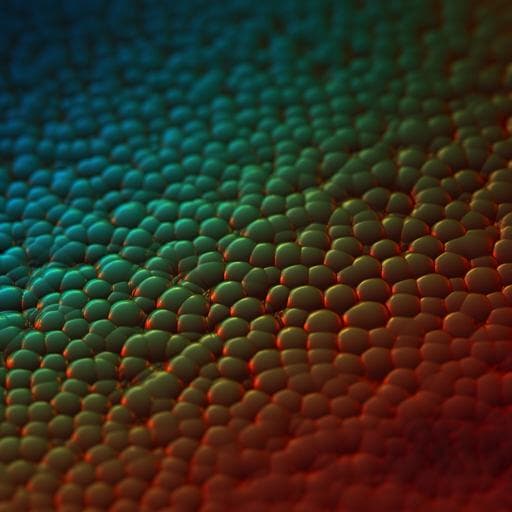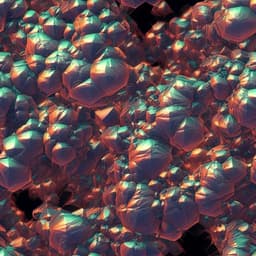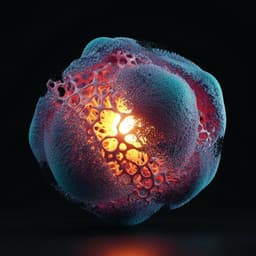
Engineering and Technology
Insights into interfacial effect and local lithium-ion transport in polycrystalline cathodes of solid-state batteries
S. Lou, Q. Liu, et al.
This groundbreaking research by Shuaifeng Lou, Qianwen Liu, Fang Zhang, and their colleagues reveals that the inner environments of polycrystalline particles significantly influence ion transport in solid-state batteries. Despite initial contact challenges, lithium-ion transport can remain homogeneous until cycling disrupts the equilibrium, leading to capacity fading. Discover how these insights could reshape our understanding of battery efficiency.
~3 min • Beginner • English
Introduction
The study addresses how solid–solid interfacial contact and local microstructural environments within polycrystalline cathode particles govern Li-ion transport and electrochemistry in all-solid-state lithium batteries (ASSLBs). Conventional understanding blames discontinuous physical contact at solid–solid interfaces for sluggish interfacial kinetics and poor performance, unlike liquid-electrolyte LIBs where interfaces are conformal and highly conductive. However, fundamental mechanisms of solid–solid interfacial kinetics remain ambiguous. This work probes whether initial discontinuous interfacial contact alone limits performance, and investigates the role of interior local ionic-electronic equilibrium within polycrystalline NCM particles in enabling or degrading Li-ion transport. Understanding these mechanisms is critical for designing durable ASSLBs with stable interfaces and mitigating chemomechanical degradation.
Literature Review
Background literature emphasizes: the need for high ionic conductivity electrolytes and low-resistance interfaces in solid-state batteries; well-established interfacial kinetics in liquid systems (Butler–Volmer, Marcus, adatom-reaction models) but ambiguity for solid–solid interfaces; concerns that discontinuous contact causes high impedance and heterogeneous state-of-charge (SOC) and stress; complexity added by polycrystalline cathodes with grain boundaries creating tortuous pathways. Prior studies report chemomechanical interplay and reaction heterogeneity in layered oxides, and that electrolyte penetration in LELBs promotes homogeneous reactions. There is limited direct experimental evidence for how physical contact loss impacts interfacial ion transport in ASSLBs, motivating operando studies connecting local chemistry, transport, and mechanics.
Methodology
Materials and cells: Commercial LiNi0.6Co0.2Mn0.2O2 (NCM) polycrystalline secondary particles (~10 µm) used as cathode. For in-operando experiments, slurry with NCM:acetylene black:PEO/LiTFSI = 50:30:20 (wt%) in acetonitrile was cast on carbon paper and vacuum-dried (60 °C, 72 h) to form a single-particle layer electrode. ASSLB coin cells (CR2025) with a hole window were assembled in Ar glovebox, using Li metal anode and solid polymer electrolyte (PEO, Mw 5,000,000, complexed with LiTFSI), no liquid added. Windows sealed with Kapton. LELBs were similarly assembled but using 1 M LiPF6 in EC/DEC/DMC (1:1:1 vol%) liquid electrolyte. For bulk electrochemistry measurements, a separate electrode formulation (NCM:acetylene black:PEO = 80:10:10 wt%) was cast on Al foil and assembled in CR2025 cells.
Electrochemical testing: Galvanostatic charge/discharge at 60 °C for ASSLBs (3.0–4.2 V) on Neware CT-4000; LELBs at 25 °C. Cyclic voltammetry at 0.2 mV s−1. In-situ EIS during charging at 0.2 C and 60 °C, 0.01–100 kHz, collected every 30 min. GITT during discharge/charge at 0.1 C with 30 min current pulses and 2 h relaxation; Li diffusion coefficients estimated using D_Li = (Δx)^2/(4t)(ΔE/Δc), with Li metal anode overpotential negligible, focusing on NCM cathode diffusivity.
In-operando X-ray spectromicroscopy: Conducted at NSLS-II beamline FXI-18. 2D TXM-XANES mapping at Ni K-edge to track SOC evolution within single NCM particles during initial charging (delithiation). XANES series collected from 8033–8055 eV in 2 eV steps; one TXM image per step with 20 ms exposure; pixels binned 2×2; SOC maps obtained by fitting to reference spectra (pristine LiNi0.6Mn0.2Co0.2O2 and fully charged Ni0.6Mn0.2Co0.2O2). Hard X-rays provide ~30–50 nm spatial resolution.
X-ray nanotomography: 3D morphology of cycled particles acquired with 8 keV X-rays, 361 projections over 180°, field of view ~40×40 µm2, sub-50 nm 3D resolution; run-out correction and standard reconstruction performed.
Synchrotron XRD/XAS: XRD to assess lattice parameter shifts after cycling; Ni K-edge XANES/EXAFS to evaluate Ni valence and local coordination (Ni–O, Ni–M) in pristine vs 50-cycle electrodes for ASSLBs and LELBs.
Finite element modeling (FEM): Polycrystalline NCM particles constructed via Voronoi tessellation into polygonal primary grains with random sizes/orientations. Electrochemistry applied as surface source/sink (local current density assumed constant). In ASSLBs, 66.7% of surface grains reactive, 33.3% non-reactive to emulate partial contact; in LELBs, 100% reactive. Mass transfer (Li diffusion) solved first (Fick’s law), then quasi-steady elastic response computed using concentration-dependent orthotropic stiffness. Chemical strain ε^c = β c with β11=β22=2.8%, β33=4.0%. Anisotropic diffusivity: D[100]=5×10−15, D[010]=5×10−15, D[001]=1×10−20 m2 s−1. Implemented in COMSOL 5.3 with detailed mesh (≈282k tetrahedra, average mesh quality 0.662).
Imaging/analysis software: PyXAS used for 2D XANES analysis. Experimental cells included realistic architecture (Li foil, solid PEO electrolyte, metal components) with X-ray access through windowed coin cells.
Key Findings
- Initial electrochemical performance: Despite discontinuous solid–solid contact, ASSLBs show initial capacity and reversibility comparable to LELBs at 0.2 C. Irreversible capacity: ASSLBs 26 mA h g−1 vs LELBs 24 mA h g−1; initial Coulombic efficiency: ASSLBs 84% vs LELBs 87%.
- EIS during first charge: Total resistance decreases during charging; anode interfacial resistance declines slowly; cathode interfacial resistance decreases significantly, indicating activation and stabilization of solid–solid interfaces in the first cycle.
- Macroscopic Li diffusion (GITT): Relaxation overpotentials higher in ASSLBs, but estimated D_Li in NCM across SOC is of the same order as LELBs (≈10−12–10−11 cm2 s−1) at low rates. High-rate transport is more limited in ASSLBs.
- In-operando TXM-XANES (initial charge): In ASSLBs, delithiation initiates at accessible surface regions with anisotropic propagation due to tortuous paths and partial contact; nevertheless, by end of charge, SOC becomes relatively homogeneous across the particle owing to internal ionic–electronic equilibration driven by electric fields and concentration gradients. In LELBs, conformal wetting yields a classical core–shell delithiation with an annular lithium-poor shell initially, leading to homogeneous SOC at full charge.
- Ionic/electronic conductivities: NCM bulk mixed-conducting and relatively conductive (≈10−3 S cm−1), while PEO-based SPE is lower (≈10−4 S cm−1); initial interfacial energy barriers and partial contact cause non-equilibrium fields that increase overpotential but do not prevent full delithiation at low rates.
- Cycling stability: After 50 cycles at 0.5 C (after activation), LELBs retain ≈85% capacity, whereas ASSLBs retain ≈51%. Increased polarization and resistance accompany ASSLB degradation.
- Post-cycling morphology and chemistry (ASSLBs): SEM and 3D nanotomography reveal numerous microcracks within NCM secondary particles; voids and contact loss at interfaces observed. 2D TXM-XANES maps show heterogeneous SOC with pronounced core–surface differences. XRD shows a −0.04° shift (increased interplanar spacing) vs pristine. Ni K-edge XANES shows +0.4 eV edge shift (higher Ni valence). EXAFS amplitude reductions for Ni–O and Ni–M indicate distortion of octahedral NiO6 and decreased cation ordering, consistent with excess Ni3+ (Jahn–Teller active).
- Post-cycling (LELBs): No obvious microcracks in SEM or tomography; SOC maps remain homogeneous; minimal changes in XANES/EXAFS peak amplitudes.
- Mechanism from FEM: Partial reactive surfaces in ASSLBs produce non-uniform Li concentration fields at intermediate SOC, generating tensile stress near surfaces and compressive stress in cores, with heterogeneity along grain boundaries due to anisotropic diffusion and crystal orientation. Repeated non-equilibrated cycling promotes intergranular microcrack initiation and propagation, increasing transport resistance and SOC heterogeneity.
- Overall insight: Initial discontinuous physical contact does not necessarily limit first-cycle interfacial ion transport due to internal equilibration within mixed-conducting polycrystalline particles; long-term cycling leads to chemo-mechanical degradation (microcracks, contact loss), which then dominates capacity fading in ASSLBs.
Discussion
The findings demonstrate that the conventional emphasis on continuous physical interfacial contact as the primary determinant of ASSLB performance is incomplete. For mixed-conducting polycrystalline NCM, internal ionic–electronic coupling allows SOC equilibration across grains even when external solid–solid contact is partial, resulting in comparable initial reversibility to LELBs at low rates. Operando spectromicroscopy confirms that initial anisotropic interface-limited delithiation evolves toward homogeneous SOC by the end of charge.
However, the same interfacial constraints create persistent non-equilibrium concentration gradients and stress heterogeneity during cycling. FEM and 3D imaging link these gradients to tensile–compressive stress fields along grain boundaries, driving intergranular microcracking. In ASSLBs, non-fluid electrolytes cannot wet newly formed internal surfaces, amplifying contact loss, transport barriers, and SOC heterogeneity. This feedback accelerates resistance growth, polarization, structural distortion (higher Ni valence, Jahn–Teller effects), and rapid capacity fade. In contrast, LELBs maintain electrolyte access and homogeneous stress distributions, preserving structure and performance.
These results clarify that sustaining interior local environment equilibrium within polycrystalline cathode particles and stabilizing solid–solid interfaces are critical for durable ASSLB operation.
Conclusion
This work visualizes and quantifies how local interfacial environments and internal transport in polycrystalline NCM govern ASSLB behavior. Key contributions: (1) Contrary to conventional assumptions, initial discontinuous solid–solid contact does not preclude high reversibility; internal ionic–electronic equilibration yields near-uniform SOC by end of first charge. (2) Long-term cycling induces SOC heterogeneity, microcracking, and structural distortion in ASSLBs, leading to rapid capacity fade, as confirmed by operando TXM-XANES, 3D nanotomography, XRD, and XAS analyses, and supported by FEM.
Design implications and future directions: employ single-crystalline or densified polycrystalline cathodes to reduce grain-boundary resistance and cracking; engineer solid electrolytes with enhanced mechanical compliance/plasticity to accommodate volume change; optimize electrode architectures for 3D ionic–electronic percolation while mitigating electrolyte decomposition at carbon interfaces; develop zero/low-strain electrode materials; and pursue interface engineering to maintain continuous reactive contact over cycling. Extending operando multimodal imaging to other chemistries and rates will further generalize these insights.
Limitations
- Material/system specificity: Results are based on NCM (LiNi0.6Co0.2Mn0.2O2) with PEO/LiTFSI solid polymer electrolyte at 60 °C; conclusions may differ for other cathodes or inorganic solid electrolytes with different mechanics and conductivity.
- Rate/temperature regime: Comparable initial performance is demonstrated at low C-rates; at higher rates, interface limitations are more pronounced. LELBs operated at 25 °C vs ASSLBs at 60 °C, potentially affecting comparisons.
- Operando imaging scope: In-operando TXM-XANES focuses on the initial charge; long-term evolution is assessed ex-situ after 50 cycles, not continuously monitored operando.
- Modeling assumptions: FEM assumes constant local current density, specified anisotropic diffusivities, linear stiffness–concentration scaling, and partial surface reactivity fractions; real electrodes may exhibit additional complexities (e.g., plasticity, fracture mechanics, interphase growth).
- Chemical side reactions: While mechanical cracking is emphasized, contributions from electrolyte oxidation (e.g., PEO), interphase formation, and cathode–electrolyte interfacial chemistry are not fully deconvoluted.
Related Publications
Explore these studies to deepen your understanding of the subject.







